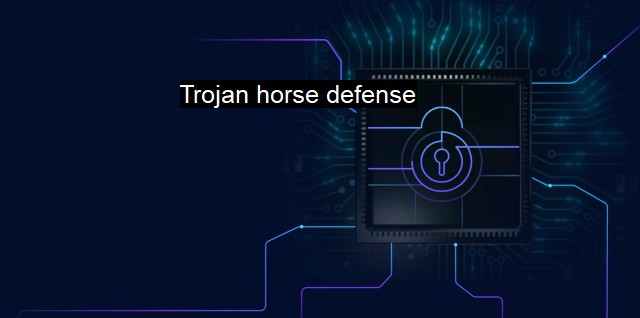What is Trojan horse defense?
The Importance of Trojan Horse Defense in Cybersecurity: A Comprehensive Overview
The "Trojan horse" concept in computing is derived from the famous story in Greek mythology where the Greeks used a wooden horse, presented as a gift to deceive the city of Troy into allowing it into their city walls. The hollow wooden horse was filled with Greek soldiers who, under cover of darkness, exited the horse and opened the city gates, effectively conquering the city of Troy. the term "Trojan horse defense" is used as a metaphor for deceptive techniques conducted in digital systems that can result in unauthorized access, system compromise and data theft.A trojan horse (also known simply as trojan) when applied to computing, is a type of malicious software created by attackers designed to mislead users of its true intent. That is, they present themselves as something harmless, legitimate, or desirable, but they clandestinely contain something harmful such as a virus, a worm, or ransomware that can infringe on the cybersecurity of your computer system. This form of deception is a significant cybersecurity threat and it has been used in major cyber-attacks worldwide, as it effectively tricks users into unwittingly installing malware onto their devices, which can unleash a host of undesirable outcomes ranging from data theft to system failure.
Trojan horse malware is designed to exploit the trust that users put into software providers. A common method involves tricking individuals into downloading software on their computer or device. In relation to their design, a trojan often looks like a legitimate file or program from a reputable source. Users trying to download free versions of paid software or pirated content are typical targets of a Trojan horse malware. While the downloaded file looks innocent and normal on the surface, it carries a hidden destructive element to it.
More sophisticated Trojans can also avoid detection by the anti-malware programs and therefore require more advanced security techniques to be identified and eliminated. Consequences of a trojan horse attack can be drastic: they can delete files, steal sensitive data like passwords or financial information, allow cybercriminals to spy on you, disrupt the performance of the computer, or, in extreme cases, even allow the cybercriminal to control your device.
"mathematical groups">The defenses against Trojan Horse involve user vigilance and advanced security software. Users should strictly avoid downloading content from websites that are not trustworthy or clicking on suspicious email attachments. It is also advisable to keep all software and the operating system updated because updates often include patches for security vulnerabilities that a Trojan Horse may exploit.
Another form of defense against Trojans involves application control techniques. That means all unauthorized applications can be automatically blocked from running until authorized.
Cybersecurity technologies such as antivirus programs are designed to scan, detect, and remove malware, including trojans. They often include real-time scanning which helps in detecting threats as they occur. Therefore, it is essential to have the most advanced antivirus software installed and always up-to-date on your device. Another tool useful in protection against trojans is a firewall. It provides a protective barrier between your personal network and the external internet, alerting the system about any suspicious incoming or outgoing activities.
A crucial thing in trojan horse defense is constant user education and awareness about cybersecurity threats, safe internet behavior, and the significance of backing up data on a regular basis. User decisions are often the decisive factor between a secure system and an infected one.
a trojan horse defense involves maintaining proper digital hygiene, consistent user diligence, regular updates to all software, using advanced security software, including antivirus software and firewalls, and most importantly, user awareness about the scope of cybersecurity threats existing on the Internet today.

Trojan horse defense FAQs
What is a Trojan horse in cybersecurity?
A Trojan horse is a type of malware that disguises itself as a legitimate software or file to gain access to a computer system. Once inside, it can steal or manipulate data, install other malware, and even provide unauthorized access to the attacker.What is Trojan horse defense?
Trojan horse defense refers to the measures taken to prevent or detect Trojan horse attacks in a computer system. This includes using antivirus software, keeping all software up to date, using firewalls, being cautious when opening email attachments or downloading software, and regularly backing up important data.How does antivirus software help in Trojan horse defense?
Antivirus software uses a database of known malware signatures to detect and remove malicious files, including Trojan horses. It scans files and emails for any suspicious activity and can quarantine or delete any infected files. It is important to keep antivirus software up to date to ensure it can detect the latest threats.What are some signs of a Trojan horse attack?
Signs of a Trojan horse attack may include a slow or unresponsive computer, pop-ups or ads appearing on the screen, unexpected changes to files or settings, and suspicious network activity. If you suspect a Trojan horse attack, it is important to disconnect from the internet and run a full system scan with your antivirus software.| | A | | | B | | | C | | | D | | | E | | | F | | | G | | | H | | | I | | | J | | | K | | | L | | | M | |
| | N | | | O | | | P | | | Q | | | R | | | S | | | T | | | U | | | V | | | W | | | X | | | Y | | | Z | |
| | 1 | | | 2 | | | 3 | | | 4 | | | 7 | | | 8 | | |||||||